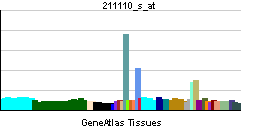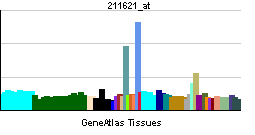Androgen receptor
| Androgen receptor (dihydrotestosterone receptor; testicular feminization; spinal and bulbar muscular atrophy; Kennedy disease) | |||
|---|---|---|---|
 PDB rendering based on 2AM9. | |||
| Identifiers | |||
| Symbols | AR ; AIS; DHTR; HUMARA; KD; NR3C4; SBMA; SMAX1; TFM | ||
| External IDs | Template:OMIM5 Template:MGI HomoloGene: 28 | ||
| RNA expression pattern | |||
 | |||
 | |||
| More reference expression data | |||
| Orthologs | |||
| Template:GNF Ortholog box | |||
| Species | Human | Mouse | |
| Entrez | n/a | n/a | |
| Ensembl | n/a | n/a | |
| UniProt | n/a | n/a | |
| RefSeq (mRNA) | n/a | n/a | |
| RefSeq (protein) | n/a | n/a | |
| Location (UCSC) | n/a | n/a | |
| PubMed search | n/a | n/a | |
|
WikiDoc Resources for Androgen receptor |
|
Articles |
|---|
|
Most recent articles on Androgen receptor Most cited articles on Androgen receptor |
|
Media |
|
Powerpoint slides on Androgen receptor |
|
Evidence Based Medicine |
|
Cochrane Collaboration on Androgen receptor |
|
Clinical Trials |
|
Ongoing Trials on Androgen receptor at Clinical Trials.gov Trial results on Androgen receptor Clinical Trials on Androgen receptor at Google
|
|
Guidelines / Policies / Govt |
|
US National Guidelines Clearinghouse on Androgen receptor NICE Guidance on Androgen receptor
|
|
Books |
|
News |
|
Commentary |
|
Definitions |
|
Patient Resources / Community |
|
Patient resources on Androgen receptor Discussion groups on Androgen receptor Patient Handouts on Androgen receptor Directions to Hospitals Treating Androgen receptor Risk calculators and risk factors for Androgen receptor
|
|
Healthcare Provider Resources |
|
Causes & Risk Factors for Androgen receptor |
|
Continuing Medical Education (CME) |
|
International |
|
|
|
Business |
|
Experimental / Informatics |
The androgen receptor (AR), also known as NR3C4 (nuclear receptor subfamily 3, group C, member 4), is a type of nuclear receptor which is activated by binding of either of the androgenic hormones testosterone or dihydrotestosterone.[1] The main function of the androgen receptor is as a DNA binding transcription factor which regulates gene expression.[2] However the androgen receptor also has additional functions independent of DNA binding[3]
The androgen receptor is most closely related to the progesterone receptor, and progestins in higher dosages can block the androgen receptor.
Structure
Two isoforms of the androgen receptor (A and B) have been identified:[4]
- AR-A - 87 kDa - N-terminus truncated (lacks the first 187 amino acids)
- AR-B - 110 kDa - full length
Domains
Like other nuclear receptors, the androgen receptor is modular in structure and is comprised of the following functional domains labeled A through F:
- A/B) - N-terminal regulatory domain contains:[5]
- activation function 1 (AF-1) between residues 101 and 370 required for full ligand activated transcriptional activity
- activation function 5 (AF-5) between residues 360-485 is responsible for the constitutively activity (activity without bound ligand)
- dimerization surface involving residues 1-36 (containing the FXXLF motif where F = phenylalanine, L = leucine, and X = any amino acid residue) and 370-494 which both interact with the LBD in an unusual (for a nuclear receptor) head-to-tail interaction[6][7][8]
- C) - DNA binding domain (DBD)
- D) - Hinge region - flexible region that connects the DBD with the LBD; influences subcellular trafficking
- E) - Ligand binding domain (LBD) containing
- activation function 2 (AF-2), responsible for agonist induced activity (activity in the presence of bound agonist)
- AF-2 binds both coactivator proteins (containing the LXXLL motif) and/or the AF-1 region of another molecule of androgen receptor (containing the FXXLF motif) to form a head-to-tail dimer[8]
- F) - C-terminal domain
Gene
The AR gene for the androgen receptor is located on the X chromosome at Xq11-12.
Function
Genomic
In some cell types testosterone interacts directly with androgen receptors while in others testosterone is converted by 5-alpha-reductase to dihydrotestosterone, an even more potent agonist for androgen receptor activation. Testosterone appears to be the primary androgen receptor activating hormone in the Wolffian duct while dihydrotestosterone is the main androgenic hormone in the urogenital sinus, urogenital tubercle, and hair follicles.
The primary mechanism of action for androgen receptors is direct regulation of gene transcription. The binding of an androgen to the androgen receptor results in a conformational change in the receptor which in turn causes dissociation of heat shock proteins, dimerization, and transport from the cytosol to the cell nucleus where the androgen receptor dimer binds to a specific sequence of DNA known as a hormone response element. Androgen receptors interact with other proteins in the nucleus resulting in up or down regulation of specific gene transcription. Up-regulation or activation of transcription results in increased synthesis of messenger RNA which in turn is transcribed by ribosomes to produce specific proteins. One of the known target genes of androgen receptor activation is insulin-like growth factor I (IGF-1). Thus, changes in levels of specific proteins in cells is one way that androgen receptors control cell behavior.
Androgens cause slow epiphysis, or maturation of the bones, but more of the potent epiphysis effect comes from the estrogen produced by aromatization of androgens. Steroid users of teen age may find that their growth had been stunted by androgen and/or estrogen excess. People with too little sex hormones can be short during puberty but end up taller as adults as in androgen insensitivity syndrome or estrogen insensitivity syndrome.
Non-genomic
More recently, androgen receptors have been shown to have a second mode of action. As has been also found for other steroid hormone receptors such as estrogen receptors, androgen receptors can have actions that are independent of their interactions with DNA.[3][9] Androgen receptors interact with certain signal transduction proteins in the cytoplasm. Androgen binding to cytoplasmic androgen receptors can cause rapid changes in cell function independent of changes in gene transcription, such as changes in ion transport. Regulation of signal transduction pathways by cytoplasmic androgen receptors can indirectly lead to changes in gene transcription, for example, by leading to phosphorylation of other transcription factors.
One function of androgen receptor that is independent of direct binding to its target DNA sequence, is facilitated by recruitment via other DNA binding proteins. One example is Serum Response Factor, a protein which activates several genes that cause muscle growth.[10]
AR deficiencies
The androgen insensitivity syndrome, formerly known as testicular feminization, is caused by a mutation of the Androgen Receptor gene located on the X chromosome (locus:Xq11-Xq12). The androgen receptor seems to affect neuron physiology and is defective in Kennedy disease.
References
- ↑ Roy AK, Lavrovsky Y, Song CS, Chen S, Jung MH, Velu NK, Bi BY, Chatterjee B (1999). "Regulation of androgen action". Vitam. Horm. 55: 309–52. PMID 9949684.
- ↑ Mooradian AD, Morley JE, Korenman SG (1987). "Biological actions of androgens". Endocr. Rev. 8 (1): 1–28. PMID 3549275.
- ↑ 3.0 3.1 Heinlein CA, Chang C (2002). "The roles of androgen receptors and androgen-binding proteins in nongenomic androgen actions". Mol. Endocrinol. 16 (10): 2181–7. doi:10.1210/me.2002-0070. PMID 12351684.
- ↑ Wilson CM, McPhaul MJ (1994). "A and B forms of the androgen receptor are present in human genital skin fibroblasts". Proc. Natl. Acad. Sci. U.S.A. 91 (4): 1234–8. doi:10.1073/pnas.91.4.1234. PMID 8108393.
- ↑ Jenster G, van der Korput HA, Trapman J, Brinkmann AO (1995). "Identification of two transcription activation units in the N-terminal domain of the human androgen receptor". J. Biol. Chem. 270 (13): 7341–6. doi:10.1074/jbc.270.13.7341. PMID 7706276.
- ↑ Langley E, Zhou ZX, Wilson EM (1995). "Evidence for an anti-parallel orientation of the ligand-activated human androgen receptor dimer". J. Biol. Chem. 270 (50): 29983–90. doi:10.1074/jbc.270.50.29983. PMID 8530400.
- ↑ Berrevoets CA, Doesburg P, Steketee K, Trapman J, Brinkmann AO (1998). "Functional interactions of the AF-2 activation domain core region of the human androgen receptor with the amino-terminal domain and with the transcriptional coactivator TIF2 (transcriptional intermediary factor2)". Mol. Endocrinol. 12 (8): 1172–83. doi:10.1210/me.12.8.1172. PMID 9717843.
- ↑ 8.0 8.1 Dubbink HJ, Hersmus R, Verma CS, van der Korput HA, Berrevoets CA, van Tol J, Ziel-van der Made AC, Brinkmann AO, Pike AC, Trapman J (2004). "Distinct recognition modes of FXXLF and LXXLL motifs by the androgen receptor". Mol. Endocrinol. 18 (9): 2132–50. doi:10.1210/me.2003-0375. PMID 15178743.
- ↑ Fix C, Jordan C, Cano P, Walker WH (2004). "Testosterone activates mitogen-activated protein kinase and the cAMP response element binding protein transcription factor in Sertoli cells". Proc Natl Acad Sci U S A. 101 (30): 10919–24. doi:10.1073/pnas.0404278101. PMID 15263086.
- ↑ Vlahopoulos S, Zimmer WE, Jenster G, Belaguli NS, Balk SP, Brinkmann AO, Lanz RB, Zoumpourlis VC, Schwartz RJ (2005). "Recruitment of the androgen receptor via serum response factor facilitates expression of a myogenic gene". J. Biol. Chem. 280 (9): 7786–92. doi:10.1074/jbc.M413992200. PMID 15623502.
See also
External links
- Androgen+Receptors at the US National Library of Medicine Medical Subject Headings (MeSH)
- Androgen receptor gene database
- Androgen physiology: receptor and metabolic disorders
- Molecular Mechanisms of Androgen Receptor Interactions